Valve seats seem to be a fairly simple engine component, but they play a critical role in sealing compression and cooling the valves. When a seat becomes worn, it may leak compression and allow the valve to run hotter than normal. The same thing can happen if the seat is out-of-round or has lost its concentricity with respect to the valve.
However, any mismatch between the valve and seat, therefore, will have negative consequences on sealing, the operating temperature of the valves and valve longevity. So, when the cylinder heads on high-mileage engines are rebuilt, its especially important to pay close attention to the condition of the valve seats.
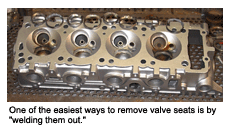 Seat Salvaging
Seat Salvaging
In the case of cast iron heads with integral valve seats, as long as the seats are undamaged, free from cracks and have not receded into the head, they can be recut or reground to restore the sealing surface. If the seats are damaged or too badly worn to be remachined, the old seats can be cut out and replaced with inserts if the head is worth the effort to repair and has enough casting thickness to accept seat inserts.
With nonintegral seats in aluminum heads, its pretty much the same story with a couple of exceptions. As long as the original seats are in relatively good condition (not loose, cracked or heavily worn), they can usually be touched up with a cutter or grinding stones to restore the surface. But sometimes the seats are loose or have hairline cracks or other damage. In these cases, the original seat must be removed and replaced with a new one preferably a seat that is made of the same or better material than the original.
Many late-model domestic and import engines have seats that are made of powder metal. These types of seats are very hard and durable, so they typically show little wear at high mileages. Consequently, the seats may need little work when the cylinder head is rebuilt. Even so, powder metal seats tend to be very hard (up to Rockwell 40 to 50) and can be difficult to machine. As long as you have equipment that can cut hard powder metal seats, remachining the seats should be no problem. But if you dont have equipment that is designed for this kind of work, you may be better off replacing the seats with new ones to restore the proper finish and seal.
Powder metal seats harden as they age, so new powder metal seats are much softer (typically around Rockwell C 25) and easier to machine than aged seats. One supplier of aftermarket powder metal seats puts a smooth radius on the outside edge of their seats to make them easier to press into place.
Seat Matchup
The key to achieving a long lasting valve seat is to match the seat alloy with the application and replace same with same or better. As a rule, most experts recommend replacing OEM valve seats with ones that are of a similar material except in cases where extra durability is required because of a change in fuels (converting to propane or natural gas, for example), or an engine is being built for racing.
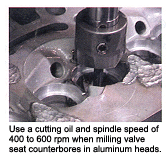 Replacement valve seats are available in a wide variety of alloys and types, from the more common standard cast iron alloys to harder nickel alloys to exotic alloys like copper beryllium for racing engines with titanium valves. And theres powder metal, too.
Replacement valve seats are available in a wide variety of alloys and types, from the more common standard cast iron alloys to harder nickel alloys to exotic alloys like copper beryllium for racing engines with titanium valves. And theres powder metal, too.
Suppliers of cast alloy valve seats typically offer a variety of different alloys, so the best advice is to follow their recommendations as to which material works best in a particular application. One supplier may not agree with another as to which alloy they would recommend for a particular application, but one point they all agree on is to use the same alloy or type of seat within the engine. In other words, dont just replace one or two seats with an alloy that differs from the OEM alloy and leave the rest alone. Replace all the seats with the same alloy.
Powder Metal Magic
One difference between cast alloy seats and powder metal seats is the way the seats are manufactured. Cast alloy seats are made by melting and mixing different metals together so they combine chemically. The molten soup is then poured into a mold and cast to shape. The rate of cooling and subsequent heat treatment of the metal determines its microstructure, hardness, strength and other physical properties.
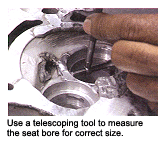 Powder metal seats, by comparison, are made by mixing together various dry metal powders such as iron, tungsten carbide, molybdenum, chromium, vanadium, nickel, manganese, silicon, copper, etc.), pressing the mixed powders into a die, then subjecting the die to high heat and pressure (a process called sintering). This causes the powders to bond together and form a solid composite matrix with very uniform and consistent properties.
Powder metal seats, by comparison, are made by mixing together various dry metal powders such as iron, tungsten carbide, molybdenum, chromium, vanadium, nickel, manganese, silicon, copper, etc.), pressing the mixed powders into a die, then subjecting the die to high heat and pressure (a process called sintering). This causes the powders to bond together and form a solid composite matrix with very uniform and consistent properties.
One of the advantages of powder metal sintering is that materials that are difficult or impossible to mix together in a molten state can be blended together and bonded to create totally unique materials. For example, in powder metal bushings and ball joints, graphite is combined with steel to make the material self-lubricating. This eliminates the need for grease and periodic maintenance.
Another advantage of the powder metal process is that parts can be manufactured very close to final tolerances, reducing the amount of machining thats needed to finish the part to size. This lowers production costs and boosts manufacturing productivity.
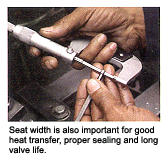 The main reason why vehicle manufacturers have switched from cast alloy seats to powder metal seat inserts is to extend durability. Most late model engines have to be emissions-certified to 150,000 miles or higher depending on the application and model year. If the valve seats cant go the distance during durability testing, the vehicle manufacturer cant certify the engine.
The main reason why vehicle manufacturers have switched from cast alloy seats to powder metal seat inserts is to extend durability. Most late model engines have to be emissions-certified to 150,000 miles or higher depending on the application and model year. If the valve seats cant go the distance during durability testing, the vehicle manufacturer cant certify the engine.
Powder metal seats are very good at handling thermal stress as well as impact stress, and typically show minimal wear after tens of thousands of miles of use. The homogeneous consistency of a powder metal seat also improves heat transfer, which is good for the valves, too. Powder metal seats also tend to experience less micro-welding between the seat and valve even at high combustion temperatures, which helps extend the life of both components.
Please Take A Seat
The first step in replacing an integral valve seat is getting the seat out of the head. Any number of techniques can be used, ranging from pulling and prying to heat shrinking, cutting and machining. Sometimes thermal cleaning alone will do the trick. When the heads get hot, the seats fall out. Those that dont can be extracted by whatever means works best for you.
One way to remove stubborn cast alloy seats that works well is to weld a small bead on the inside diameter of the seat. When the weld cools and contracts, it shrinks the seat and pulls it loose. Unfortunately, this technique does not work with powder metal seats.
If an old seat has loosened up and is moving, the counterbore in the head should be enlarged to accept an oversize replacement seat. Simply pressing in a new seat probably wont work because the interference fit has been lost. Using some anaerobic sealer to hold a new seat in place is no guarantee it will stay put if there is not enough interference to lock it in place.
If the original seat was loose, if the counterbore is flared more than .001 (wider at the top than the bottom), or if the difference between the counterbores inside diameter (ID) and a standard seats outside diameter (OD) isnt enough to provide the desired interference fit, then machining will be necessary.
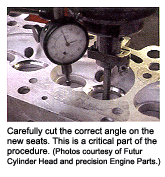 Insider Information
Insider Information
Most seat suppliers say staking, peening and/or the use of anaerobic sealer should not be necessary if a seat is installed with the proper amount of interference fit in the counterbore. The amount of interference required to lock a seat in place depends on the diameter of the seat (the larger the seat, the greater the interference thats required), the type of head (aluminum or cast iron), the application (hotter running applications typically require more interference to keep the seats from falling out), and in some cases the type of material used in the seat itself (hard seats cant take as much interference as softer seats).
Some experts recommend using a minimum of .003 interference in a cast iron head up to a maximum of .006, and .005 for aluminum heads up to a maximum of about .008. There are always exceptions, and no two experts seem to agree on this subject. One machinist may say .005 to .006 of interference fit is all he ever uses on aluminum and cast iron heads while another says cast iron heads need more interference than aluminum heads to keep the seats in place.
Something else to keep in mind when replacing seats is that any head straightening, crack repairs or welding should be completed before you cut the counterbores and install new seats. The process of straightening a head can often push seats out of round and create misalignment between the seats and guides.
Before installing a seat, make sure the counterbore is clean and has a smooth surface finish. The seat should be placed with the radius or chamfer side down and lubricated (ATF works fine) prior to being pressed or driven in with a piloted driver (recommended to prevent cocking).
If the replacement seat has a sharp edge, it should be chamfered or rounded so it wont scrape metal off the head as it is being driven into place. If metal gets under the seat, it will create a gap that forms a heat barrier. This, in turn, will interfere with the seats ability to cool the valve and premature valve failure will likely result.
Preheating the head and/or chilling the seats with dry ice or carbon dioxide are also tricks that can make installation easier and lessen the danger of broaching the counterbore as the seat is being installed.
Seat Refinishing
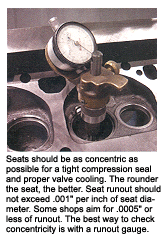 The same precaution goes for guide reconditioning. The guides must be replaced, reamed to oversize or relined before the seats are machined because the pilot for the seat cutter or grinding stone centers in the guide. Seats must be as concentric as possible to maximize valve sealing and cooling. A good number to aim for here is less than .001 of runout per inch of seat diameter. Less is always best.
The same precaution goes for guide reconditioning. The guides must be replaced, reamed to oversize or relined before the seats are machined because the pilot for the seat cutter or grinding stone centers in the guide. Seats must be as concentric as possible to maximize valve sealing and cooling. A good number to aim for here is less than .001 of runout per inch of seat diameter. Less is always best.
The best way to check concentricity is with a runout gauge. Pulling vacuum on the valve port with the valve in place is another method for checking the mating of the seat and valve. But the ability to hold vacuum is no guarantee of concentricity in itself. Thats why both methods should be used to check the quality of your work.
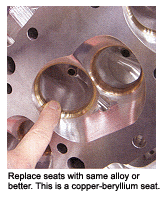 As a rule, refinishing powder metal seats requires a slightly different touch than cast alloy seats. If grinding, you typically need harder stones (ruby, nickel-chrome or stellite). If cutting, you need a good sharp carbide cutter and to slow it down a bit.
As a rule, refinishing powder metal seats requires a slightly different touch than cast alloy seats. If grinding, you typically need harder stones (ruby, nickel-chrome or stellite). If cutting, you need a good sharp carbide cutter and to slow it down a bit.
The one thing you want to avoid when cutting powder metal is any chatter on the seat surface. Powder metal seats can accept a high quality finish, but the finish is only as good as the tools that are used to cut them.
| What if Your Seats Dont Match?
Youll probably run into trouble down the road. If a replacement seat is harder than the original seat, it will hold up better than the remaining original seats. Sooner or later one of the other seats will burn a valve and the engine will be back. So if one exhaust seat is bad, replace all the exhaust seats. Different seat materials can be used for the intake and exhaust valves because the exhaust valves run so much hotter than the intakes. For a racing application, you might only need to upgrade the exhaust seats to handle the extra heat. The valve seat material must also be compatible with the type of valves that are used. For racing engines with titanium valves, copper beryllium or nickel aluminum bronze seats are usually recommended. These materials can also be used with stainless steel and stellite valves, too. Again, follow your suppliers recommendations for which type of seats they recommend for certain valves. |
| Did You Know
For dry fuel (propane and natural gas) and high load (diesel and racing) applications, harder seat materials are almost always recommended. These include tool steel tungsten carbide seats and high nickel alloy seats. |


